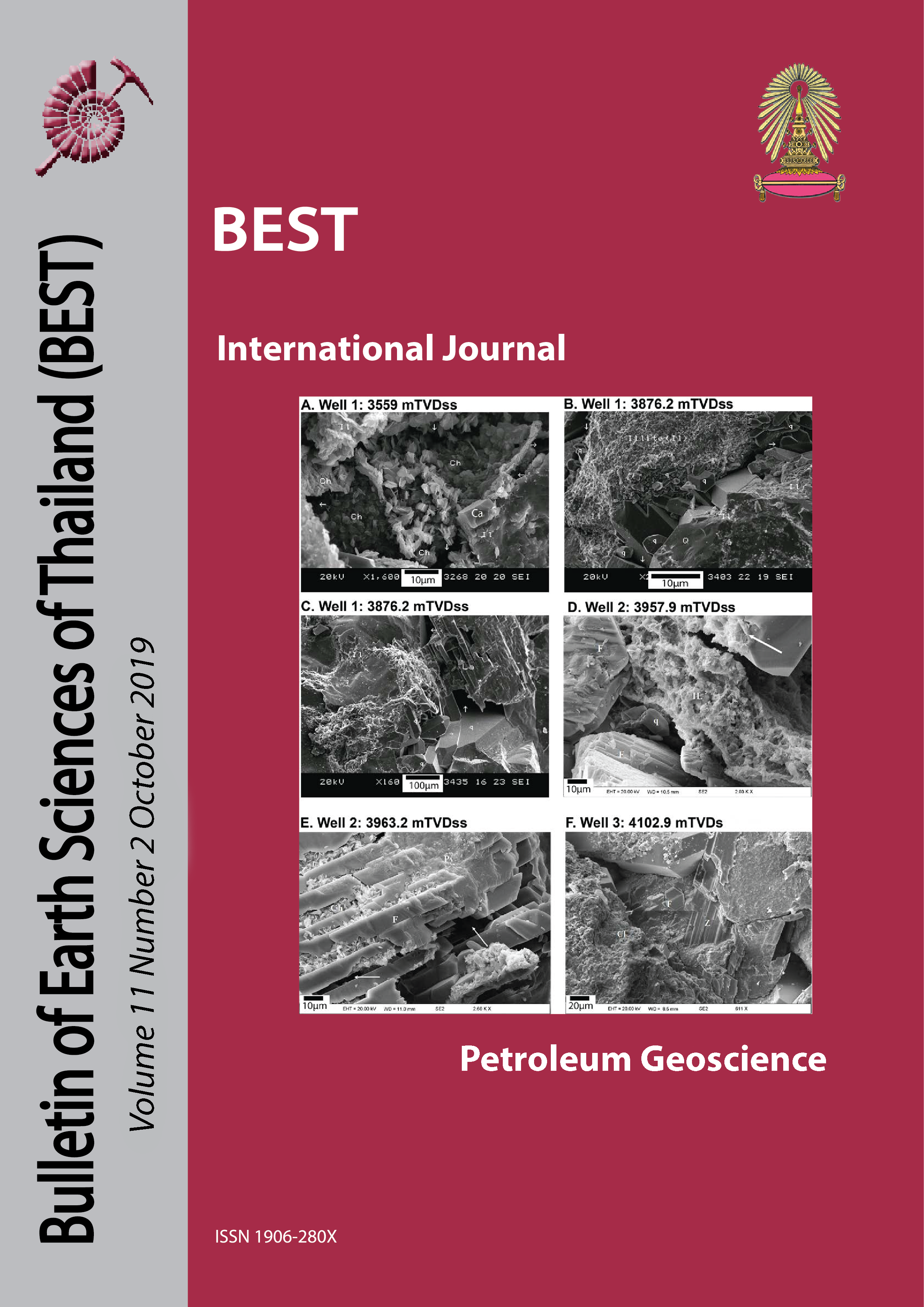Seismic Sequence Stratigraphy and Deepwater Turbidite Characteristics in The East Andaman Basin, Offshore Myanmar
Main Article Content
Abstract
Currently, turbidite reservoir is favorable for deepwater exploration. This paper presents a seismic sequence stratigraphy and deepwater turbidite distribution within the Miocene to Present-day succession in the East Andaman Basin, offshore Myanmar using 2D and 3D seismic data. Four sequences (A to D) were defined based on seismic facies characters in combination with seismic attribute analysis and global sea level change information. Major turbidite reservoir is predicted in sequence A (Early to Middle Miocene) particularly in by-pass channel which is characterized by steep-walled with U-shaped cross sections. This stacked turbidite channel is the primary exploration target in this region where slope canyon plays an important conduits for the transfer of sediment to the deepwater area.
Article Details

This work is licensed under a Creative Commons Attribution-NonCommercial-NoDerivatives 4.0 International License.
Copyright © 2008 Department of Geology, Faculty of Science, Chulalongkorn University. Parts of an article can be photocopied or reproduced without prior written permission from the author(s), but due acknowledgments should be stated or cited accordingly.
References
Berend van Hoorn, 2014, Structural Setting of Turbidite Systems: A Global Comparison, p. 40. Chotpitayasunon, T., Siriyoot, P., and Ya-anan, C., 2014, Andaman Basin Paleogeography, The key to find oil potential?: AAPG/MGS Conference, August 14-15, 2014.
Bouma, A.H. 1985. Introduction to submarine fans and related turbidite systems. In: Bouma, A., Normark, W. and Barnes, N. (eds.), Submarine Fans and Related Turbidite Systems. Springer-Verlag, New York, 3–6.
Bourget, J., Zaragosi, S., Mulder, T., Schneider, J.-L., Garlan, T., Van Toer, A., Mas, V. and Ellouz-Zimmermann, N. 2010. Hyperpycnalfed turbidite lobe architecture and recent sedimentary processes: A case study from the Al Batha turbidite system, Oman margin. Sedimentary Geology, 229, 144-159.
Catuneanu, O.W., Galloway, E., Kendall, C.G. St. C., Miall, A.D., Posamentier, H.W., Strasser, A. and Tucker, M.E., 2011. Sequence stratigraphy: Methodology and nomenclature, Newsletters on Stratigraphy, Stuttgart, 44(3), 173–245.
Curray, J. R., 2005, Tectonics and history of the Andaman Sea region. Journal of Asian Earth Sciences, v.25, p.187–232.
García, M., Ercilla, G., Alonso, B., Estrada, F., Jané, G., Mena, A., Alvés, T. and Juan, C., 2015. Deep-water turbidite systems: a review of their elements, sedimentary processes and depositional models. Their characteristics on the Iberian margins. Boletín Geológico y Minero, 126 (2-3): 189 218 ISSN: 0366-0176
Jha, P., Ros, D., and Kishore, M., 2012, Seismic and sequence stratigraphic framework and depositional architecture of shallow and deepwater postrift sediments in East Andaman basin: An overview: Search and Discovery Article no. 50566(2012).
Morley, C.K., 2013, Discussion of tectonic models for Cenozoic strike-slip fault-affected continental margins of mainland SE Asia. Journal of Asian Earth Sciences, v.76 (2013), p.137–151.
Morley, C.K., 2017, Cenozoic rifting, passive margin development and strike-slip faulting in the Andaman Sea: a discussion of established v. new tectonic models, chapter 4, p. 27-50.
Nichlos, G., 2009, Sedimentology and Stratigraphy, Wiley and Sons, New York, 225246.
Polachan, S. & Racey, A. 1994: Stratigraphy of the Mergui Basin, Andaman Sea: Implications for Petroleum Exploration. Journal of Petroleum Geology, 17 (4), 373-406.
Racey A.; Ridd M. F., 2015. Petroleum Geology of Myanmar. Retrieved from https://pubs.geoscienceworld.org/books/book/1 782/petroleum-geology-of-myanmar Salvador, A. (Ed.), 1994, International Stratigraphic Guide, p. 214. Geological Society of America, Boulder.
Srisuriyon, K., and Morley, C.K., 2014, Pullapart development at overlapping fault tips: Oblique rifting of a Cenozoic continental margin, northern Mergui Basin, Andaman Sea, Geosphere, v. 10, p. 80-106.
Twichell, D.C., Schwab, W.C., Nelson, C.H., Kenyon, N.H. and Lee, H.J. 1992. Characteristics of a sandy depositional lobe on the outer Mississippi Fan from SeaMARC 1A sidescan sonar images. Geology, 20, 693–696.
Vail, P. R., Mitchum, R. M. Jr., Thompson, S., III, 1977. Seismic stratigraphy and global changes of sea level, part four: global cycles of relative changes of sea level. American Association of Petroleum Geologists Memoir 26, 83–98.
Vail, P. R., Audemard, F., Bowman, S. A., Eisner, P. N., Perez-Cruz, C., 1991. The stratigraphic signatures of tectonics, eustasy and sedimentology – an overview. In: Einsele, G., Ricken, W., Seilacher, A. (eds), Cycles and Events in Stratigraphy. Springer–Verlag, p. 617–659.
Van Wagoner, J. C., Posamentier, H.W., Mitchum, R. M., Vail, P. R., Sarg, J. F., Loutit, T. S., Hardenbol, J., 1988. An overview of sequence stratigraphy and key definitions. In: Wilgus, C. K., Hastings, B. S., Kendall, C. G. St. C., Posamentier, H.W., Ross, C. A., Van Wagoner, J. C. (Eds.), Sea Level Changes – An Integrated ApproachSEPM Special Publication 42, 39–45.
Wandrey C.J., 2006, Eocene to Miocene Composite Total Petroleum System, IrrawaddyAndaman and North Burma Geologic Provinces, Myanmar.
Yanqing Huang, 2018, Sedimentary characteristics of turbidite fan and its implication exploration in Lower Congo Basin.


